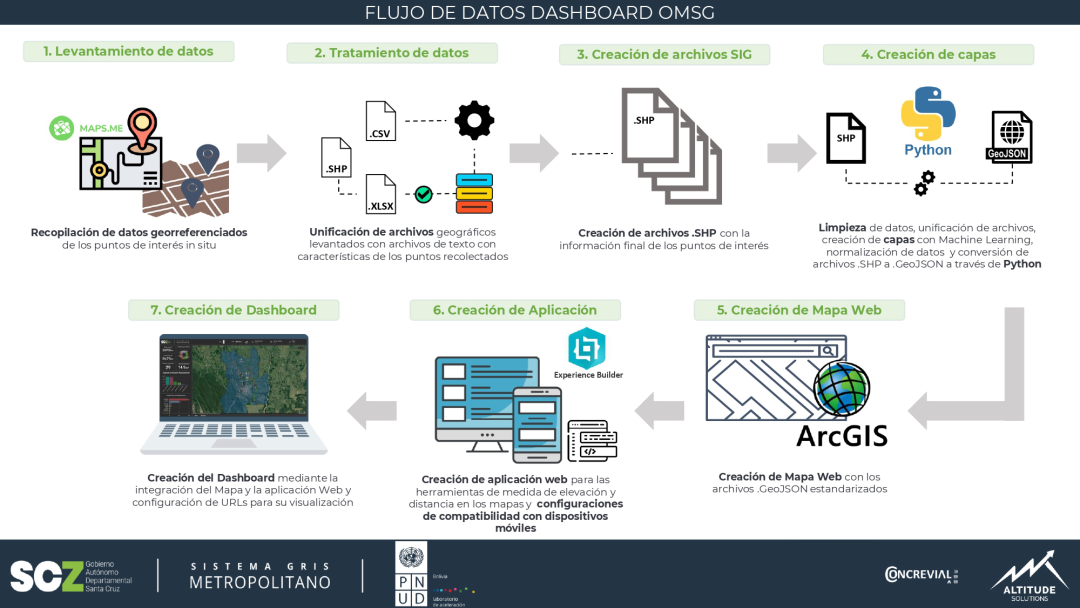Disclaimer:
Please be aware that the content herein has not been peer reviewed. It consists of personal reflections, insights, and learnings of the contributor(s). It may not be exhaustive, nor does it aim to be authoritative knowledge.
Overview
Prepared by (Name of the experimenter)
Metropolitan Observatory
On date (Day/Month/Year)
28/03/2023
What action learning plan is this activity related to?
The "Data and Informed Decisions" experiment is related to an action learning plan focused on smart urban development and sustainable metropolitan planning. The plan aims to integrate evidence-based decision-making by using data and geospatial tools to address urban challenges in the Santa Cruz metropolitan area. It promotes data-driven governance, enhancing infrastructure management, urban mobility, and environmental sustainability through strategic use of GIS, real-time data, and visualization dashboards
Design
What is the specific learning intent of the activity? Why is it important to do this experiment?
Specific Learning Intent of the Activity:
The intent is to understand how evidence-based metropolitan planning can improve the sustainability, infrastructure management, and urban mobility of the Santa Cruz metropolitan area. The activity focuses on using geospatial data and advanced analytical tools to make informed decisions that enhance city planning and development.
Why Is It Important?
This experiment is important because it enables data-driven governance, which leads to more efficient resource allocation, improved urban equity, and greater environmental sustainability in response to rapid urban growth
What is your hypothesis? IF... THEN....
IF geospatial data and evidence-based planning are implemented in the metropolitan area, THEN urban development will become more sustainable, efficient, and responsive to infrastructure and environmental challenges, improving decision-making and quality of life for inhabitants.
Does the activity use a control group for comparison?
No, it does not use a control group
Describe which actions, with whom, where, when will you (or did you) take to test your hypothesis:
Actions to Test the Hypothesis:
Data Collection:
Collect geospatial data using remote sensors, GIS tools, and in situ methods like Maps.me in the Santa Cruz metropolitan area.
Collaboration:
Work with an interdisciplinary team from the Autonomous Departmental Government of Santa Cruz and the Metropolitan Observatory for data processing.
Implementation:
Analyze and visualize the data using platforms like ArcGIS and integrate it into the Metropolitan Observatory Dashboard to inform decision-making.
Timeline:
The experiment took place during the design and rollout of the Observatory Dashboard
If you worked with partners, please choose what sector they belong to (select all that apply)
Academia, Private Sector, Government (& related)
What is the total estimated monetary resources needed for this experiment?
Between 1,000 and 9,999 USD
Please upload any supporting images or visuals for this experiment.
Please upload any supporting links
Results
Was the original hypothesis (If.. then) proven or disproven? In which way do the results support the original hypothesis or not?
As the project involved data collection and implementation in the Metropolitan Observatory of Santa Cruz, the original hypothesis—if geospatial data and evidence-based planning are used, urban development will be more sustainable and efficient—was proven. The integration of geospatial data through tools like ArcGIS allowed for better decision-making in infrastructure and environmental planning, resulting in improved urban mobility and sustainability in the Santa Cruz metropolitan area
What are the most important learning outcomes of the experiment? Are any changes recommended?
Most Important Learning Outcomes:
Improved Decision-Making: Evidence-based planning significantly improved urban mobility and infrastructure management in the Santa Cruz metropolitan area.
Data-Driven Governance: The use of geospatial data enhanced the municipality’s ability to address environmental and infrastructural challenges.
Sustainability Focus: The methodology promoted sustainable development by incorporating real-time data for strategic decisions.
Recommended Changes:
Expand Data Sources: Incorporate more diverse data points (e.g., real-time traffic data).
Ongoing Updates: Continuously update data to reflect changing urban dynamics.
Considering the outcomes of this experimental activity, which of the following best describe what happened after? (Please select all that apply)
This experiment influenced public policy at a national or local level
Please include any supporting images that could be used to showcase this activity
Please add any supporting links that describe the planning, implementation, results of learning of this activity? For example a tweet, a blog, or a report.
Learning
What were the main obstacles and challenges you encountered during this activity? What advise would you give colleagues trying to replicate this experimental activity?


 9Industry, innovation and infrastructure
9Industry, innovation and infrastructure 11Sustainable cities and communities
11Sustainable cities and communities 13Climate action
13Climate action


Comments
Log in to add a comment or reply.